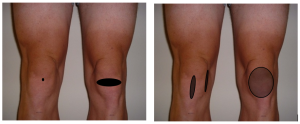By Dr Ebonie Rio
Key points
- Many structures can drive pain that is felt at the front of the knee
- Differentiation of where the pain is (localised versus vague) appears to be associated with different changes to muscle drive / excitability
Anterior knee pain (pain at the front of the knee) can be caused by many different structures including the tendon that connects your quadriceps muscle group of your thigh to your lower leg (patellar tendon), joint (patellofemoral joint) fat pad under the patellar tendon, bursae (fluid filled sacks around the knee) and other sneaky less common causes such as plica.
So how important is it to try to work out what is causing the pain at the front of the knee?
We recently used fancy brain equipment know as Transcranial magnetic stimulation was able to record information about the amount of drive / excitability to the quadriceps muscles (see publication here). Think of the excitability like the accelerator of a car. This study compared people with ‘patellar tendon pain’ to people with other forms of anterior knee pain which was more vague (see Figure), and also people without knee pain. All people in the study were jumping athletes and that’s important because activity can affect your muscle drive (and the part of your brain that controls that movement).
What was interesting was even though the two groups with pain had similar amounts of pain on clinical testing and had pain for a similar length of time, their accelerator was completely different! The group with ‘patellar tendon pain’ (known as patellar tendinopathy or sometimes jumpers knee) had increased excitability compared with those with ‘other forms of anterior knee pain’ (best describes patellofemoral pain, fat pad etc) and those without any knee pain. Even though both groups had pain at the front of the knee, the control / drive to the quadriceps muscle was different. This implies that our treatment approaches and therefore clinical differentiation of these presentations need to be different and specific to the person in front of us. Stay tuned for future blogs on how we may treat these clinical presentations differently including how to target the brain!


